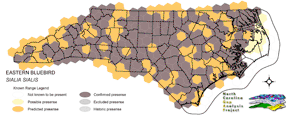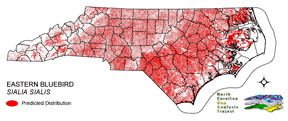
| Taxa: |
| Order: |
| Family: |
| Aves |
| Passeriformes |
| Turdidae |
| NatureServe Global Rank: |
| NatureServe State (NC) Rank: |
| G5 |
| S5B,S5N |
| Federal Status: |
| NC State Status: |
| --- |
| --- |


| Land Unit |
| US Fish & Wildlife Service |
| US Forest Service |
| US National Park Service |
| US Department of Defense |
| NC State Parks |
| NC University System |
| NC Wildlife Res. Com. |
| NC Forest Service |
| NC Div. of Coastal Mgmt. |
| Local Governments |
| Non-Governmental Org. |
| Other Public Lands |
| Private Lands |
| GAP Status 1-2 |
| All Protected Lands |
| Statewide |
| Hectares |
| 8,392.95 |
| 22,228.92 |
| 64,255.86 |
| 2,683.08 |
| 6,228.36 |
| 4,429.17 |
| 28,556.01 |
| 4,844.28 |
| 52.11 |
| 1,271.70 |
| 3,193.02 |
| 3,473.10 |
| 5,026,262.04 |
| 29,129.88 |
| 147,511.02 |
| 5,175,870.60 |
| Acres |
| 20,739.43 |
| 54,928.85 |
| 158,779.66 |
| 6,630.03 |
| 15,390.61 |
| 10,944.72 |
| 70,563.42 |
| 12,247.28 |
| 128.77 |
| 3,142.44 |
| 7,890.12 |
| 8,582.22 |
| 12,420,161.57 |
| 72,258.29 |
| 364,784.41 |
| 12,790,129.11 |
| % of Dist. on |
| Prot. Lands |
| 5.7 % |
| 15.1 % |
| 43.5 % |
| 1.8 % |
| 4.2 % |
| 3.0 % |
| 18.7 % |
| 3.3 % |
| < 0.1 % |
| 2.1 % |
| 2.1 % |
| 1.9 % |
| < 0.1 % |
| 19.7 % |
| ----- |
| ----- |
| % of Dist. on |
| All Lands |
| 0.2 % |
| 0.4 % |
| 1.2 % |
| < 0.1 % |
| 0.1 % |
| < 0.1 % |
| 0.6 % |
| < 0.1 % |
| < 0.1 % |
| < 0.1 % |
| < 0.1 % |
| < 0.1 % |
| 97.1 % |
| 0.6 % |
| ----- |
| ----- |
|
Absent on the barrier islands (Fussell and Lyons 1990); present throughout the rest of the state (Potter et al. 1980). Bluebirds forage in short sparse vegetation (Nicholson 1997), and nest in cavities located in fairly isolated trees (Alsop 1991). These requirements can be found in a variety of semi-open habitats with scattered trees, such as farms, roadsides, burned areas, forest clearings, open pine woods, suburbs (Kaufman 1996), swamps (Harrison 1975), lawns, and golf courses (Nicholson 1997). Requires a nesting cavity located away from other overhanging trees (Alsop 1991). Cavities may include old woodpecker holes, birdhouses (Harrison 1975), mailboxes, or holes in fence posts (Potter et al. 1980). NATURE SERVE GLOBAL HABITAT COMMENTS: Forest edge, open woodland, and partly open situations with scattered trees, from coniferous or deciduous forest to riparian woodland but most frequently in pine-oak association, also pine woodland or savanna in tropics. Nests in natural cavity, old woodpecker hole, bird box, or similar site, 1-6 m above ground. Nesting holes often are usurped by starlings and house sparrows. |
| Code | Name | Description | NC Natural Heritage Program Equivalent |
| 97 | Mesic Longleaf Pine | Longleaf pine woodlands without a major scrub oak component. Slash or loblolly pines may be present as well. | Mesic Pine Flatwoods |
| 42 | Xeric Longleaf Pine | Sandhills including a range of longleaf pine density from predominantly wiregrass, scrub oak dominated to true longleaf pine woodland. This does not include mesic or saturated flatwood types. | Xeric Sandhill Scrub, Pine/Scrub Oak Sandhill, Coastal Fringe Sandhill |
| 46 | Xeric Oak - Pine Forests | Mixed forest dominated by yellow pines with white or northern red oaks co-dominating. | Pine Oak Heath |
| 232 | Xeric Pine-Hardwood Woodlands and Forests | Mixed forest dominated by yellow pines with drier oaks including southern red, post, and chestnut oaks. | Dry Oak Hickory Forest |
| 226 | Piedmont Xeric Woodlands | Generally post and blackjack oak dominated woodlands. White ash and pignut hickory can be found in combination with Eastern red cedar on glades. | Xeric Hardpan Forest |
| 20 | Coniferous Regeneration | Regenerating pine stands. Predominantly loblolly pine, but slash and longleaf stands occur as well. | No equivalent |
| 36 | Successional Deciduous Forests | Regenerating deciduous trees with a shrub stature. Commonly dominated by sweetgum, tulip poplars and maples. | No equivalent |
| 180 | Agricultural Crop Fields | Farm fields used for row crops. | No equivalent |
| 205 | Agricultural Pasture/Hay and Natural Herbaceous | Farm fields used for pasture grass or hay production, as well as old fields dominated by native and exotic grasses. | No equivalent |
| 202 | Residential Urban | Includes vegetation interspersed in residential areas. Includes lawns, mixed species woodlots, and horticultural shrubs. Vegetation accounts for between 20 - 70% of the cover. | No equivalent |
|
Sauer, J. R., and S. Droege. 1990. Recent population trends of the eastern bluebird. Wilson Bull. 102:239-252.
Bent, A. C. 1949. Life histories of North American thrushes, kinglets, and their allies. U. S. Nat. Mus. Bull.196. 452 pp., 51 pls. Grooms, S., and D. Peterson. 1991. Bluebirds! NorthWord Press, Inc. 160 pp. Ehrlich, P.R., D.S. Dobkin, and D. Wheye. 1992. Birds in jeopardy:the imperiled and extinct birds of the United States and Canada, including Hawaii and Puerto Rico. Stanford University Press, Stanford, California. 259 pp. Fussell, J. III and M. Lyons. 1990. Birds of the Outer Banks [pamphlet]. Eastern National Parks and Monument Association Coastal Wildlife Refuge Society. Kaufman K. 1996. Lives of North American Birds. Boston, New York: Houghton Mifflin Company. Nicholson CP. 1997. Atlas of the breeding birds of Tennessee. Knoxville: University of Tennessee Press. Lumsden, H. G. 1989. Test of nest box preferences of eastern bluebirds, SIALIA SIALIS, and tree swallows, TACHYCINETA BICOLOR. Can. Field-Nat. 103:595-597. Krieg, D. 1971. The behavior patterns of the eastern bluebird. 476 pp. Harrison, H.H. 1975. A field guide to bird's nests in the U.S. east of the Mississippi River. Houghton Mifflin Company, Boston, Massachusetts. 257 p. Harrison, C. 1978. A field guide to the nests, eggs and nestlings of North American birds. Collins, Cleveland, Ohio. Harrison, H.H. 1979. A field guide to western birds' nests. Houghton Mifflin Company, Boston. 279 pp. Potter, E. F., J. F. Parnell, and R. P. Teulings. 1980. Birds of the Carolinas. Univ. North Carolina Press, Chapel Hill. 408 pp. Terres, J.K. 1980. The Audubon Society encyclopedia of North American birds. Alfred A. Knopf, New York. American Ornithologists' Union (AOU), Committee on Classification and Nomenclature. 1983. Check-list of North American Birds. Sixth Edition. American Ornithologists' Union, Allen Press, Inc., Lawrence, Kansas. McComb, W. C., W. H. Davis, and P. N. Allaire. 1987. Excluding starlings from a slot-entrance bluebird nest box. Wildl. Soc. Bull. 15:204-207. Mitchell, W.A. 1988. Songbird nest boxes. Section 5.1.8, U.S. Army Corps of Engineers, Wildlife Resources Management Manual. Tech. Rep. EL-88-19. Waterways Experiment Station, Vicksburg, Mississippi. 48 pp. Peterson, R. P. 1987. A new bluebird nesting structure for highway rights-of-way. Wildl. Soc. Bull. 15:200-204. Alsop FJ III. 1991. Birds of the Smokies. Gatlinburg: Great Smoky Mountains Natural History Association. Parren, S. G. 1991. Evaluation of nest-box sites selected by eastern bluebirds, tree swallows, and house wrens. Wildl. Soc. Bull. 19:270-277. |
For more information please contact them at:
NC-GAP Analysis Project
Dept. of Zoology, NCSU
Campus Box 7617
Raleigh, NC 27695-7617
(919) 513-2853
www.basic.ncsu.edu/ncgap